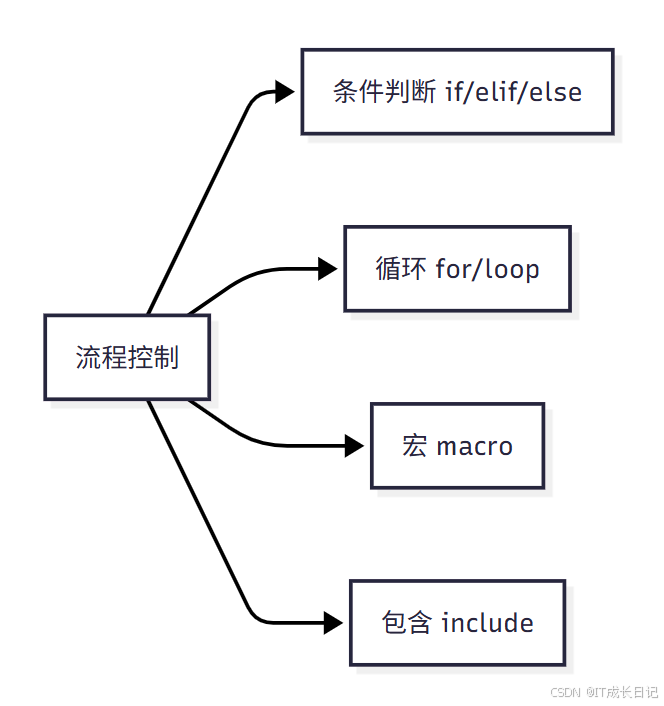【自动化运维神器Ansible】template流程控制:for循环与if条件判断详解
目录
1 流程控制概述
1.1 什么是流程控制
1.2 流程控制的类型
1.3 流程控制的重要性
2 条件判断(if/elif/else)
2.1 基本语法
2.2 简单条件判断
2.3 比较运算符
2.4 逻辑运算符
2.5 实际应用案例:根据操作系统类型配置Nginx
3 循环(for循环)
3.1 基本语法
3.2 遍历列表
3.3 遍历字典
3.4 循环控制变量
3.5 实际应用案例:配置多个Nginx虚拟主机
3.6 带条件的循环
3.7 循环中的else语句
4 嵌套循环与复杂场景
4.1 嵌套循环
4.2 循环中的特殊语法
4.3 实际应用案例:配置多个负载均衡后端服务器
5 宏(Macro)的高级应用
5.1 宏的定义与调用
5.2 带默认参数的宏
5.3 实际应用案例:使用宏简化虚拟主机配置
6 总结
在Ansible模板管理中,我们经常需要根据不同条件生成不同的配置内容,或者对列表、字典等复杂数据结构进行迭代处理。Jinja2模板引擎提供了强大的流程控制功能,包括for循环和if条件判断,使得模板能够根据实际情况动态生成配置内容。
1 流程控制概述
1.1 什么是流程控制
流程控制是编程语言中的基本概念,它允许程序根据条件执行不同的代码分支或重复执行某些代码块。在Ansible模板中,流程控制使我们能够根据变量值、主机 facts 或其他条件动态生成配置内容。
1.2 流程控制的类型

1.3 流程控制的重要性
流程控制使得Ansible模板能够:
- 根据不同环境生成差异化配置
- 处理复杂数据结构(如列表、字典)
- 实现配置的逻辑判断和条件应用
- 减少重复代码,提高模板的可维护性
2 条件判断(if/elif/else)
2.1 基本语法
{% if condition %}<!-- 条件为真时执行的代码 -->
{% elif another_condition %}<!-- 另一个条件为真时执行的代码 -->
{% else %}<!-- 所有条件都为假时执行的代码 -->
{% endif %}2.2 简单条件判断
{% if debug %}debug = true
{% else %}debug = false
{% endif %}2.3 比较运算符
{% if value > 10 %}<!-- value大于10 -->
{% endif %}{% if version == "1.0" %}<!-- version等于"1.0" -->
{% endif %}{% if name in ["nginx", "apache", "httpd"] %}<!-- name在列表中 -->
{% endif %}2.4 逻辑运算符
{% if condition1 and condition2 %}<!-- condition1和condition2都为真 -->
{% endif %}{% if condition1 or condition2 %}<!-- condition1或condition2至少一个为真 -->
{% endif %}{% if not condition %}<!-- condition为假 -->
{% endif %}2.5 实际应用案例:根据操作系统类型配置Nginx
---
- hosts: webserversvars:nginx_config:user: "{{ ansible_user | default('nginx') }}"worker_processes: "{{ ansible_processor_vcpus }}"keepalive_timeout: 65tasks:- name: Configure nginxtemplate:src: nginx.conf.j2dest: /etc/nginx/nginx.conf- 模板文件nginx.conf.j2:
user {{ nginx_config.user }};
worker_processes {{ nginx_config.worker_processes }};{% if ansible_distribution == "CentOS" %}error_log /var/log/nginx/error.log warn;pid /var/run/nginx.pid;
{% elif ansible_distribution == "Ubuntu" %}error_log /var/log/nginx/error.log;pid /run/nginx.pid;
{% endif %}events {worker_connections 1024;multi_accept on;
}http {include /etc/nginx/mime.types;default_type application/octet-stream;sendfile on;tcp_nopush on;tcp_nodelay on;keepalive_timeout {{ nginx_config.keepalive_timeout }};types_hash_max_size 2048;{% if ansible_distribution_major_version == "7" %}# CentOS 7 specific configurationssl_protocols TLSv1 TLSv1.1 TLSv1.2;{% elif ansible_distribution_major_version == "8" %}# CentOS 8 specific configurationssl_protocols TLSv1.2 TLSv1.3;{% endif %}# ... 其他配置
}3 循环(for循环)
3.1 基本语法
{% for item in sequence %}<!-- 对序列中的每个item执行的代码 -->
{% endfor %}3.2 遍历列表
{% for server in servers %}server {{ server }};
{% endfor %}3.3 遍历字典
{% for key, value in config.items() %}{{ key }} = {{ value }}
{% endfor %}3.4 循环控制变量
- Jinja2提供了多个循环控制变量:
| 变量 | 描述 |
| loop.index | 当前循环的索引(从1开始) |
| loop.index0 | 当前循环的索引(从0开始) |
| loop.revindex | 当前循环的倒序索引(从1开始) |
| loop.revindex0 | 当前循环的倒序索引(从0开始) |
| loop.first | 是否是第一次循环 |
| loop.last | 是否是最后一次循环 |
| loop.length | 序列的长度 |
| loop.depth | 当前循环的嵌套深度 |
| loop.depth0 | 当前循环的嵌套深度(从0开始) |
3.5 实际应用案例:配置多个Nginx虚拟主机
---
- hosts: webserversvars:virtual_hosts:- name: "example.com"root: "/var/www/example.com"server_name: "example.com www.example.com"index: "index.html index.htm"- name: "test.com"root: "/var/www/test.com"server_name: "test.com www.test.com"index: "index.html"tasks:- name: Configure virtual hoststemplate:src: virtual_hosts.conf.j2dest: /etc/nginx/conf.d/virtual_hosts.conf- 模板文件virtual_hosts.conf.j2:
{% for host in virtual_hosts %}
server {listen 80;server_name {{ host.server_name }};root {{ host.root }};index {{ host.index }};location / {try_files $uri $uri/ =404;}{% if host.name == "example.com" %}location /status {stub_status on;access_log off;allow 127.0.0.1;deny all;}{% endif %}
}
{% endfor %}3.6 带条件的循环
{% for host in virtual_hosts if host.enabled %}
server {# 配置内容
}
{% endfor %}3.7 循环中的else语句
{% for item in items %}{{ item }}
{% else %}<!-- 如果items为空或未定义,则执行此代码 -->No items found
{% endfor %}4 嵌套循环与复杂场景
4.1 嵌套循环
{% for category in categories %}[{{ category.name }}]{% for product in category.products %}{{ product.name }} = {{ product.price }}{% endfor %}
{% endfor %}4.2 循环中的特殊语法
{% for user in users %}{{ user.name }}{% if not loop.last %},{% endif %}
{% endfor %}4.3 实际应用案例:配置多个负载均衡后端服务器
---
- hosts: load_balancersvars:upstreams:- name: "app_servers"servers:- name: "app1"address: "192.168.10.10:8080"weight: 3- name: "app2"address: "192.168.10.11:8080"weight: 2- name: "app3"address: "192.168.10.12:8080"weight: 1- name: "api_servers"servers:- name: "api1"address: "192.168.2.10:8080"weight: 1tasks:- name: Configure upstreamstemplate:src: upstreams.conf.j2dest: /etc/nginx/conf.d/upstreams.conf- 模板文件upstreams.conf.j2:
{% for upstream in upstreams %}
upstream {{ upstream.name }} {{% for server in upstream.servers %}server {{ server.address }} weight={{ server.weight }}{% if not loop.last %};{% endif %}{% endfor %}
}
{% endfor %}server {listen 80;server_name example.com;location / {proxy_pass http://app_servers;}location /api {proxy_pass http://api_servers;}
}5 宏(Macro)的高级应用
5.1 宏的定义与调用
{% macro server_block(name, port) %}
server {listen {{ port }};server_name {{ name }};# ... 其他配置
}
{% endmacro %}{% for server in servers %}{{ server_block(server.name, server.port) }}
{% endfor %}5.2 带默认参数的宏
{% macro server_block(name, port=80, root="/var/www") %}
server {listen {{ port }};server_name {{ name }};root {{ root }};# ... 其他配置
}
{% endmacro %}5.3 实际应用案例:使用宏简化虚拟主机配置
{% macro virtual_host(name, root, server_names, port=80) %}
server {listen {{ port }};server_name {{ server_names }};root {{ root }};index index.html index.htm;location / {try_files $uri $uri/ =404;}location /status {stub_status on;access_log off;allow 127.0.0.1;deny all;}
}
{% endmacro %}{{ virtual_host(name="example.com",root="/var/www/example.com",server_names="example.com www.example.com",port=80
) }}{{ virtual_host(name="test.com",root="/var/www/test.com",server_names="test.com www.test.com",port=80
) }}6 总结
本文介绍了Ansible模板中的流程控制功能,包括条件判断(if/elif/else)和循环(for循环),以及宏的高级应用。通过这些流程控制语句,我们能够创建更加智能、灵活的配置模板,根据不同条件生成差异化的配置内容。条件判断使我们能够根据变量值、主机 facts 或其他条件动态应用配置,而循环则允许我们高效处理列表、字典等复杂数据结构,避免重复代码。宏的使用则可以进一步提高模板的可重用性和可维护性。在实际应用中,我们应该遵循最佳实践,保持模板简洁,合理使用注释,避免过度嵌套,并通过变量简化复杂逻辑。
